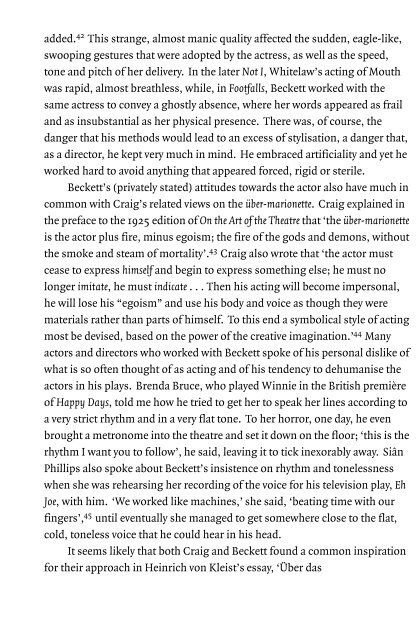You also want an ePaper? Increase the reach of your titles
YUMPU automatically turns print PDFs into web optimized ePapers that Google loves.
added. 42 This strange, almost manic quality affected the sudden, eagle-like,<br />
swooping gestures that were adopted by the actress, as well as the speed,<br />
tone and pitch <strong>of</strong> her delivery. In the later Not I, Whitelaw’s acting <strong>of</strong> Mouth<br />
was rapid, almost breathless, while, in Footfalls, <strong>Beckett</strong> worked with the<br />
same actress to convey a ghostly absence, where her words appeared as frail<br />
and as insubstantial as her physical presence. There was, <strong>of</strong> course, the<br />
danger that his methods would lead to an excess <strong>of</strong> stylisation, a danger that,<br />
as a director, he kept very much in mind. He embraced artificiality and yet he<br />
worked hard to avoid anything that appeared forced, rigid or sterile.<br />
<strong>Beckett</strong>’s (privately stated) attitudes towards the actor also have much in<br />
common with Craig’s related views on the über-marionette. Craig explained in<br />
the preface to the 1925 edition <strong>of</strong> On the Art <strong>of</strong> the Theatre that ‘the über-marionette<br />
is the actor plus fire, minus egoism; the fire <strong>of</strong> the gods and demons, without<br />
the smoke and steam <strong>of</strong> mortality’. 43 Craig also wrote that ‘the actor must<br />
cease to express himself and begin to express something else; he must no<br />
longer imitate, he must indicate . . . Then his acting will become impersonal,<br />
he will lose his “egoism” and use his body and voice as though they were<br />
materials rather than parts <strong>of</strong> himself. To this end a symbolical style <strong>of</strong> acting<br />
most be devised, based on the power <strong>of</strong> the creative imagination.’ 44 Many<br />
actors and directors who worked with <strong>Beckett</strong> spoke <strong>of</strong> his personal dislike <strong>of</strong><br />
what is so <strong>of</strong>ten thought <strong>of</strong> as acting and <strong>of</strong> his tendency to dehumanise the<br />
actors in his plays. Brenda Bruce, who played Winnie in the British première<br />
<strong>of</strong> Happy Days, told me how he tried to get her to speak her lines according to<br />
a very strict rhythm and in a very flat tone. To her horror, one day, he even<br />
brought a metronome into the theatre and set it down on the floor; ‘this is the<br />
rhythm I want you to follow’, he said, leaving it to tick inexorably away. Siân<br />
Phillips also spoke about <strong>Beckett</strong>’s insistence on rhythm and tonelessness<br />
when she was rehearsing her recording <strong>of</strong> the voice for his television play, Eh<br />
Joe, with him. ‘We worked like machines,’ she said, ‘beating time with our<br />
fingers’, 45 until eventually she managed to get somewhere close to the flat,<br />
cold, toneless voice that he could hear in his head.<br />
It seems likely that both Craig and <strong>Beckett</strong> found a common inspiration<br />
for their approach in Heinrich von Kleist’s essay, ‘Über das<br />
BECKETT AS DIRECTOR 109


